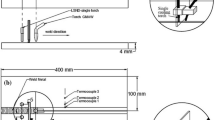Abstract
The microstructure distribution and distortion behavior of a cold work tool steel cylindrical specimen with keyway after quenching (QT) and deep cryogenic treatment (DCT) were evaluated in detail. Furthermore, from the viewpoints of thermal and volumetric strains, an attempt was made to reveal its distortion mechanism during QT and DCT. The results suggest that DCT can effectively improve the dimensional stability of specimen and eliminate the distortion caused by QT. During the QT and DCT processes, the bending direction and the curvature change of specimen are closely associated with the competition between the thermal strain induced by thermal contraction and the volumetric strain caused by martensite transformation. After DCT, the average thermal and volumetric strains of specimen are respectively about − 0.0051 mm/mm and 0.0049 mm/mm, which are decreased by about 100% and increased by around 25% compared with that of QT, respectively. During QT, the distortion behavior of specimen is governed primarily by the volumetric strain and it mainly undergoes an expansion deformation. While, during DCT, the distortion behavior of specimen is dominated by the thermal strain and it primarily encounters a contraction deformation. However, compared with the expansion deformation during QT, the contraction deformation of specimen during DCT is much more significant, which further proves that DCT is feasible to improve the dimensional stability of specimen.



















Similar content being viewed by others
References
J.R. Cho, W.J. Kang, M.G. Kim, J.H. Lee, Y.S. Lee, W.B. Bae, J. Mater. Process. Technol. 153–154, 476–481 (2004)
S.J. Lee, Y.K. Lee, Acta Mater. 56, 1482–1490 (2008)
A. Sugianto, M. Narazaki, M. Kogawara, S.Y. Kim, S. Kubota, J. Mater. Eng. Perform. 19, 194–206 (2010)
M. Preciado, P.M. Bravo, J.M. Alegre, J. Mater. Process. Technol. 176, 41–44 (2006)
F.J. Da Silva, S.D. Franco, Á.R. Machado, E.O. Ezugwu, A.M. Souza Jr., Wear 261, 674–685 (2006)
V. Leskovsek, B. Ule, Heat Treat. Met. 29, 72–76 (2002)
H. Li, W. Tong, J. Cui, H. Zhang, L. Chen, L. Zuo, Mater. Sci. Eng. A 662, 356–362 (2016)
C.H. Surberg, P. Stratton, K. Lingenhöle, Cryogenics 48, 42–47 (2008)
M. Villa, K. Pantleon, M.A.J. Somers, Acta Mater. 65, 383–392 (2014)
M. Araghchi, H. Mansouri, R. Vafaei, Y. Guo, Mater. Sci. Eng. A 689, 48–52 (2017)
T. Sonar, S. Lomte, C. Gogte, V. Balasubramanian, Procedia Manuf. 20, 113–118 (2018)
M. Jung, M. Kang, Y.K. Lee, Acta Mater. 60, 525–536 (2012)
D.K. Ju, W.M. Zhang, Y. Zhang, Mater. Sci. Eng. A 438–440, 246–250 (2006)
A. Sugianto, M. Narazaki, M. Kogawara, A. Shirayori, S.Y. Kim, S. Kubota, J. Mater. Process. Technol. 209, 3597–3609 (2009)
H.H. Bok, J.W. Choi, F. Barlat, D.W. Suh, M.G. Lee, Int. J. Plast. 58, 154–183 (2014)
D.N. Collins, Heat Treat. Met. 23, 40–42 (1996)
D. Das, A.K. Dutta, V. Toppo, K.K. Ray, Mater. Manuf. Process. 22, 474–480 (2007)
S. Zhirafar, A. Rezaeian, M. Pugh, J. Mater. Process. Technol. 186, 298–303 (2007)
V.G. Gavriljuk, W. Theisen, V.V. Sirosh, E.V. Polshin, A. Kortmann, G.S. Mogilny, Y.N. Petrov, Y.V. Tarusin, Acta Mater. 61, 1705–1715 (2013)
S.H. Li, M.G. Xiao, G.M. Ye, K.Y. Zhao, M.S. Yang, Mater. Sci. Eng. A 732, 167–177 (2018)
L.C.F. Canale, G.E. Totten, Int. J. Mater. Prod. Technol. 24, 4–52 (2005)
K. Arimoto, S. Yamanaka, M. Narazaki, K. Funatani, Int. J. Microstruct. Mater. Prop. 4, 168–186 (2009)
J.W. Li, L.L. Tang, S.H. Li, X.C. Wu, Mater. Des. 47, 653–666 (2013)
J.W. Li, Y. Feng, H.B. Zhang, N. Min, X.C. Wu, J. Mater. Eng. Perform. 23, 4237–4250 (2014)
C. Şimşir, C.H. Gür, Comput. Mater. Sci. 44, 588–600 (2008)
D.J. Kamody, Adv. Mater. Process. 154, 215–218 (1998)
Acknowledgements
This work is supported by the National Key Research and Development Program of China (Grant Nos. 2016YFB0300400 and 2016YFB0300404).
Author information
Authors and Affiliations
Corresponding authors
Rights and permissions
About this article
Cite this article
Li, J., Min, Y., Wang, P. et al. Analysis of Distortion Mechanism of a Cold Work Tool Steel During Quenching and Deep Cryogenic Treatment. Met. Mater. Int. 25, 546–558 (2019). https://doi.org/10.1007/s12540-018-00220-z
Received:
Accepted:
Published:
Issue Date:
DOI: https://doi.org/10.1007/s12540-018-00220-z




